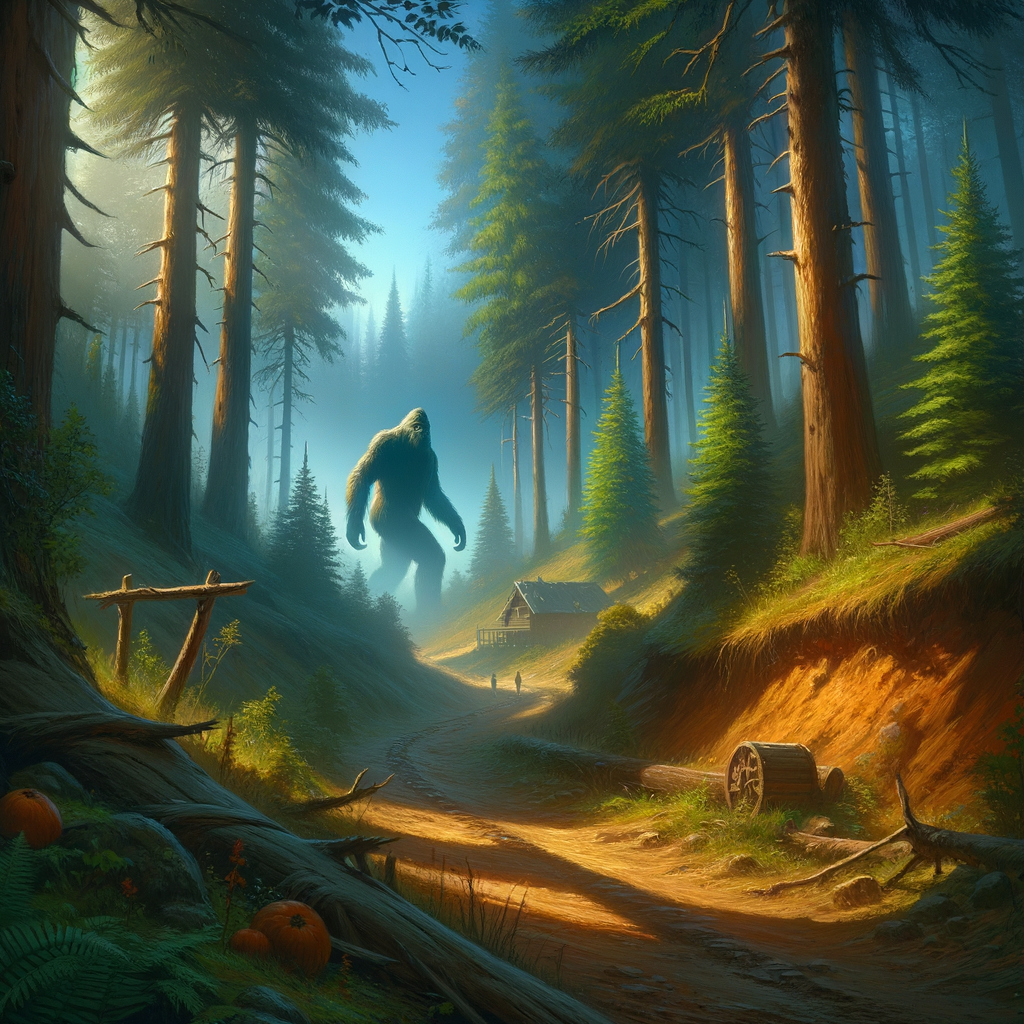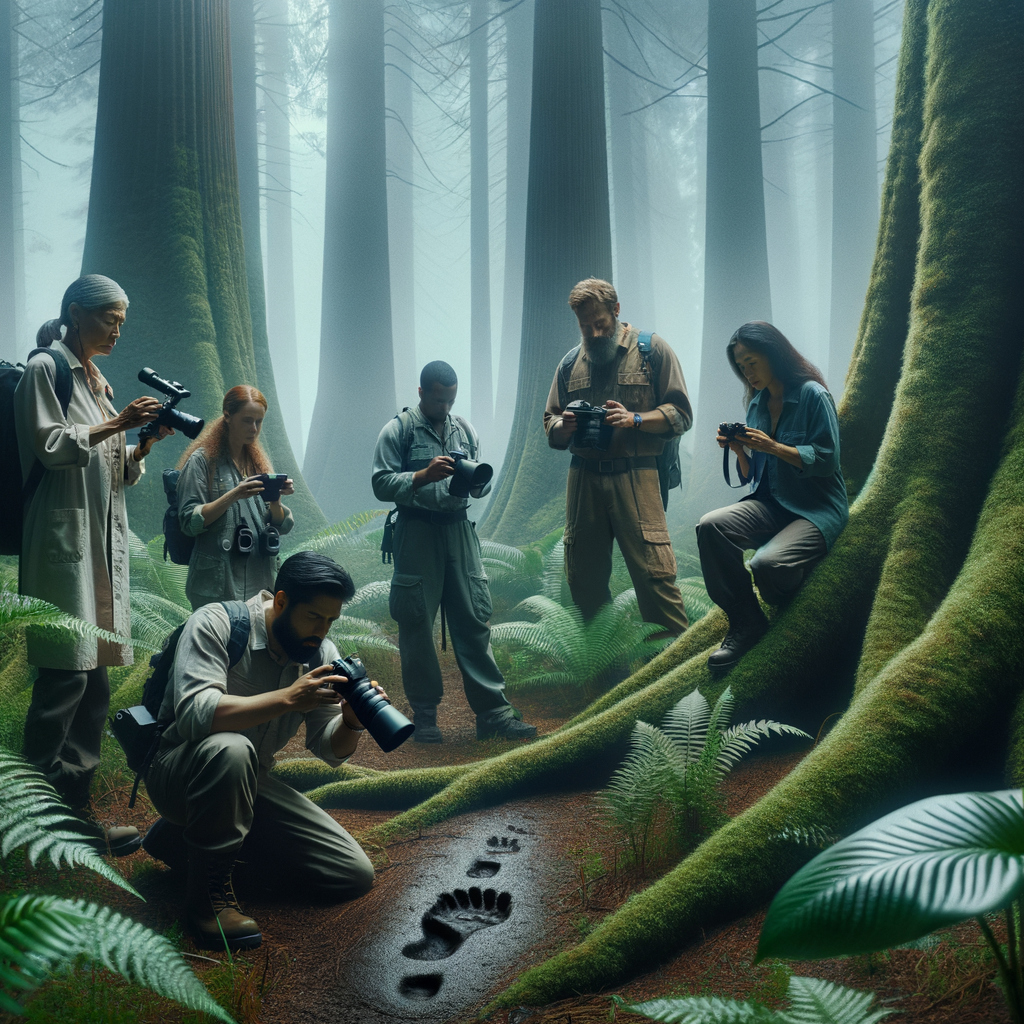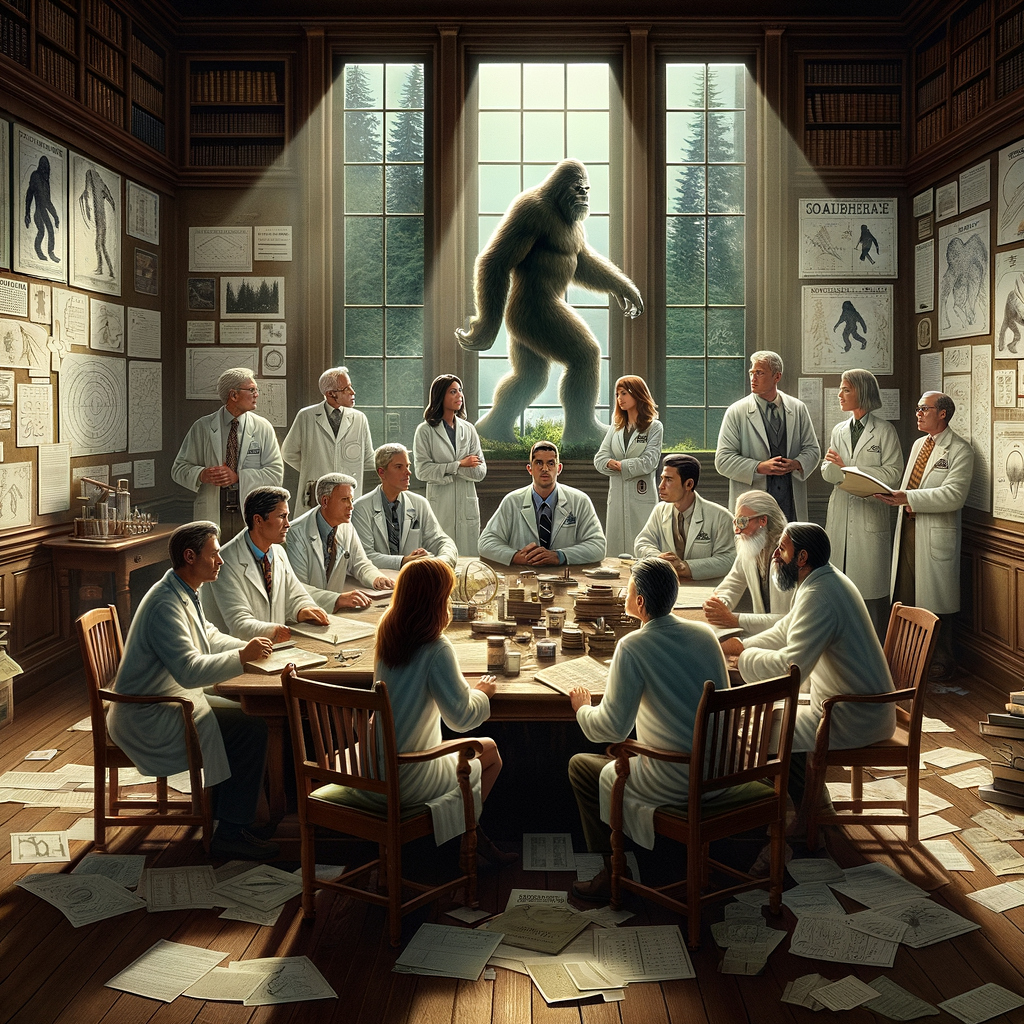
I’m going to take you through a strange yet enthralling narrative that has captivated many for decades. It’s a story that’s woven into the very tapestry of campfire lore across North America, permeating the consciousness of those who tread the forested pathways and gaze into the shadowy wilderness. You’ve probably heard the name before: Sasquatch, or as many refer to it, Bigfoot.
Now, this isn’t just about a camera-shy, woodlands-roaming giant. It’s also about a rich cultural phenomenon that’s gripped enthusiasts and skeptics alike, giving birth to a debate that, to this day, stirs the hearts of the adventurous. Canadian Sasquatch stories are not merely concocted tales; they are a pivotal part of Native American folklore, echoing beliefs and testimonies that span generations.
But Sasquatch legends aren’t unique to North America. The creature boasts counterparts in countless cultures around the globe. There’s the Yeti, also known as the Abominable Snowman in the Himalayas, and the Yowie Man of Australia to name just two. This prevalence of giant ape-like beings in so many societies begs the question: Could there be a sliver of truth amid these tales, or are they simply the products of vivid imagination?
Wildfoot Disclosure and Invitation
As an Amazon Associate I earn from qualifying purchases.
Some of the links in my blog posts are affiliate links to Amazon. This means I may earn a small commission if you decide to make a purchase, at no extra cost to you. These links are here to explore freely, with no pressure or obligation.
My blogs cover everything from Bigfoot theories and paranormal research to survival tips and personal stories. When I mention a book, tool, or piece of gear, it’s because I believe in it, use it, or have taken time to research it thoroughly.
You’ll also see connections to my other platforms, including TrailForge Gear and Paranormal Curiosities Realm all part of the same mission: to explore the unexplained and share what I find.
Thanks for reading, sharing, and supporting independent storytelling.
Shawn Thomas
Author & Creator of The Hidden Bloodlines of Bigfoot
Founder of Wildfoot Explores
I really hope that you’re ready to explore the depths of this mystery, because what follows is a recount of eyewitness encounters, theories by those who track this elusive beast, and a journey through the possibility that there may be more to the Sasquatch than just old wives’ tales and hoaxes. You’re going to find out about people who have staked their reputations on what they’ve seen or discovered, and what they believe resides in the vast wilds of Canada.
Eyewitness Accounts and Sasquatch Advocates

Imagine trekking through the dense Canadian wilderness, the air crisp and the sounds of nature your only company. Suddenly, a towering figure looms ahead, elusive, enigmatic, and almost too incredible to believe. That’s the scenario thousands have claimed to experience when they say they’ve encountered Bigfoot. Over the years, these reports have piled up, creating a tapestry of personal testimonies that continues to intrigue and mystify the public.
Sasquatch advocates don’t merely trade stories; they also weave theories. One such hypothesis suggests that Bigfoot is not a remnant of campfire lore but the offspring of an ape from Asia. They argue this ancestor ventured into North America across a land bridge during the Ice Age. Today, they hypothesize, at least 2,000 descendants of this primal traveler could be pacing the underbrush of our expansive forests.
These advocates portray Bigfoot as awe-inspiring if not a bit terrifying. An adult male allegedly stands a minimum of 8 feet tall, tips the scales at about 800 pounds, and sports feet twice the size of an average human’s. This beast is an enigma; unlike other wildlife that leave behind tangible evidence of their existence, Bigfoot seems to step lightly over the earth, escaping detection in a world where surveillance has become near ubiquitous.
Yet this lack of hard evidence doesn’t deter true believers. To them, each new reported sighting knits together a larger narrative of existence. They continue to meticulously document each account, capturing millions with the narrative of a shy giant who peeks from behind the veil of our understanding, always present but just out of reach.
The Science of Bigfoot: Searching for Evidence

I’m going to walk you through what the search for Bigfoot evidence entails. Up until now, the proof presented for Bigfoot’s existence could be politely described as ‘less than compelling’. However, despite blurry photos and contentious footprint casts, a dedicated contingent of scientists and enthusiasts goes to incredible lengths in search of definitive evidence.
The scientific inquiry into Bigfoot’s existence is fraught with controversy. Critics point out a glaring issue: unlike other elusive creatures that roam our planet, no bones or carcass of a supposed Sasquatch has ever been found. You’d think that with thousands of these creatures supposedly ambling across North America, at least one would have been discovered by now.
Then there are the hair samples collected from supposed encounters. This is exciting, right? Well, every analysis so far has been a letdown, linking the samples to more mundane creatures such as elk, bears, or cows. Despite these setbacks, the drive to continue the search is fueled by the belief that there’s more out there, waiting to be discovered.
Don’t worry too much about a lack of high-res Bigfoot selfies; advocates argue technological limitations and the creature’s rumored shyness contribute to our scant archives of visual proof. But it’s the absence of genetic evidence that has many experts scratching their heads. No one has yet to produce DNA that can’t be matched to known wildlife, which is often seen as a prerequisite for taking the next leap in proving Bigfoot’s existence.
Even with these stumbling blocks, the researchers at the fringes of science persevere. Their argument? Not pursuing the Bigfoot question leaves a gaping hole in our understanding of the natural world. This angle receives much eyebrow-raising, but they insist that enough forensic crumbs exist to merit a more thorough, scientific investigation. What could be the harm, they suggest
, in just taking a look?
Why Skepticism Prevails Among Academics

I’m going to take you through a field that’s densely populated with doubt: the academic world. You’re going to find out about the hardliner stance many scientists have taken on the Bigfoot phenomenon.
In the quest to classify the world’s creatures, scientists operate on concrete evidence: bones, DNA, clear photographs. Bigfoot, however, has skillfully circumvented these requirements, leaving scientists empty-handed and skeptical.
Shawn Thomas who has been on the trail of this debate for decades, sums it up succinctly. Without a body, there is no evidence – and for rigorous academics that’s a deal-breaker.
I’m not just talking about a clear picture or a stray bone here. We’ve seen enough blurry photos and questionable casts of footprints to last a lifetime. But when you compare the lack of definitive evidence with say, the grizzly bear, which although elusive, hasn’t managed to dodge the camera, things start to look a bit shaky for team Sasquatch.
Hair samples taken from supposed encounters, once analyzed, often tell stories of bears, elk, even cows – but not of an unknown ape-man. This isn’t just about identification, it’s also about outright trickery. Hoaxes have been a blight, eroding the credibility of any potential evidence.
Consider the case of the late Ray Wallace. His legacy isn’t filled with accolades for tracking the mysterious creature, but instead divergence of a practical joke gone too far. By stomping around with wooden feet to create giant footprints, Wallace planted the seeds of the modern Bigfoot myth that blossomed into the hulking figure debated today.
Dennett isn’t shocked by the surge in sightings either. He finds parallels with other elusive phenomena that captivate what a human imagination: the Loch Ness Monster, UFOs, apparitions. ‘The monster thing is a universal product of the human mind. We hear such stories from around the world,’ he says. Maybe, at its core, Bigfoot is not an undiscovered species but a creature born from the very essence of wonder and the unknown that lives in the human psyche.
So this brings the question: is the nationwide hunt and debate over the existence of Bigfoot a reflection of these deeply ingrained,
storytelling instincts?
Or is there a sliver of truth, waiting under the canopy of hoax and folklore, for science to uncover?
Well, there’s two ways to react to this. I shoot for the latter.
The Great Debate: Balancing Curiosity and Credibility

Navigating the terrain between fact and folklore presents us with a fascinating challenge. The Bigfoot legend, while steeped in centuries of storytelling and anecdote, inspires a sense of wonder and taps into our collective curiosity about the unknown. In my opinion, the essence of this creature is about more than just proving its existence; it’s also about understanding our desire to believe in something larger than life.
This isn’t just about science versus superstition; it’s about the human imagination and the lengths we go to explain the unexplained. Sure, evidence is sparse and credible sightings are debated, but the cultural footprint of Bigfoot is undeniable. I’m here to help you appreciate the cultural significance of such myths and how they reflect our innate fascination with nature’s mysteries.
As we look toward the future, the Bigfoot debate serves as a reminder to maintain a healthy skepticism while still honoring the imaginative spirit that sparks exploration and discovery. Your first attempt doesn’t need to be your last in the quest for understanding the world around us, and the tale of Sasquatch certainly isn’t going anywhere soon.
Now, what does it mean for us if one day science does prove the existence of Bigfoot? For the skeptics, it would be a moment of concession and perhaps a newfound respect for the unknown. For believers, validation of their claims would be a cause for celebration. However, until that day arrives—if it ever does—we are left with a narrative that is compellingly human: our drive to solve mysteries and the enduring hope that there’s still wonder in the wilderness.
Thanks for joining me on this exploration of the enigmatic legend of the Canadian Sasquatch. I urge you to keep an open mind, mixed with a dose of healthy scrutiny, as you encounter mysteries like Bigfoot. After all, it’s the search for answers that keeps our stories—and our search for truth—alive and well.
If you enjoyed this blog have a look at this one – Exploring The Basics: How To Get Started In Ghost Hunting

The article “Skeptics Vs Believers: The Great Canadian Bigfoot Debate” presents a compelling exploration of the cultural phenomenon surrounding Bigfoot, blending folklore, eyewitness accounts, scientific skepticism, and the enduring allure of the unknown.
Many people have reported sightings of Bigfoot over the years, yet these accounts are often met with skepticism. What factors contribute to the credibility of eyewitness testimonies, especially when they describe encounters with extraordinary beings like Bigfoot? How might cultural beliefs and expectations influence these reports?
Hi S.J
thanks for the great comment. As long as there are believers there will always be some one there to be skepticism. even know there are foot prints, image , videos, but that just not enough for some people but that OK because if we didn’t have both side then the Bigfoot name would not be as big i think or as interesting to talk about.
for your question 1
What factors contribute to the credibility of eyewitness testimonies, especially when they describe encounters with extraordinary beings like Bigfoot?
Well with most that do encounter Bigfoot worried about what people will think or say.but for the ones that did report all that did experience i do believe they did encounter something. If you look over most reports there are a lot of similarities between the reports. Bigfoot one same as UFO encounters.
Question 2
How might cultural beliefs and expectations influence these reports?
Well if we look at the cultural beliefs. The stories were about an 8 to 10 foot tall hair-like creature that tribes came across that they encountered and documented on walls and rocks. With the reports today are very similarities just with a bit more detail in the reports.
Hi,
This is an intriguing journey looking into the skepticism and belief surrounding the elusive Sasquatch! The blend of eyewitness accounts, scientific inquiry, and cultural significance paints a vivid picture of a debate that continues to captivate imaginations worldwide. When I travel north, I enjoy the T-shirts and posters with fun quips about Bigfoot.
I have to wonder why the excitement of this debate still lingers. What do you think: is the search for Bigfoot an exploration of tangible evidence, or a quest driven by our enduring fascination with the unknown?
– Scott
Hey Scott
Thanks for the awesome comment Glad to hear that you got yourself a T-shirt and poster That’s great i have a few myself. you know i wonder about that same topic all the time. So to answer your question
What do you think: is the search for Bigfoot an exploration of tangible evidence, or a quest driven by our enduring fascination with the unknown?
Well this is a great question and to be honest you hit it right on the head in my opinion ill explain – So the main reason i think is the enduring fascination with the unknown is the biggest point. if we did find real DNA then i think the stories of Bigfoot would fade but if we just keep finding what we are then the story can continue. But the tangible evidence something has to be putting the footprints out-there that people are finding but that great about the mystery .